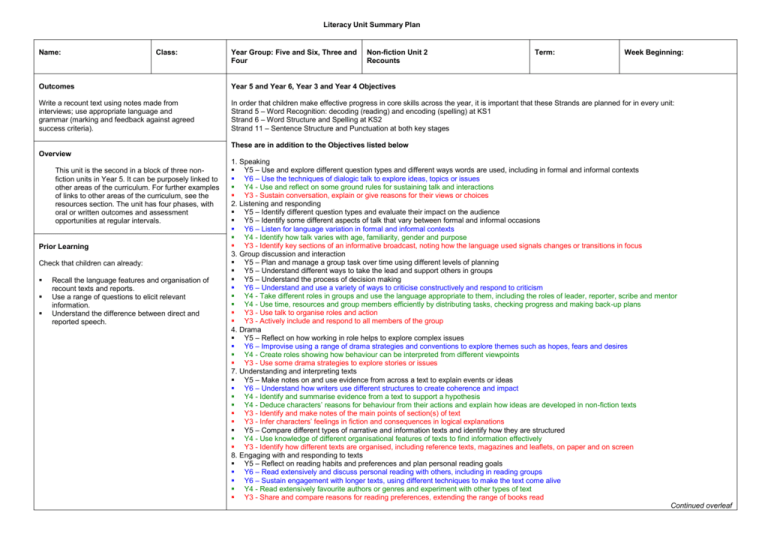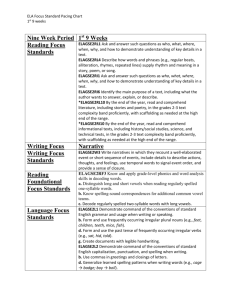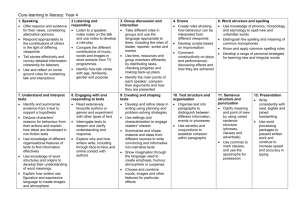Literacy Unit Summary Plan
advertisement

Literacy Unit Summary Plan Name: Class: Year Group: Five and Six, Three and Four Non-fiction Unit 2 Recounts Term: Week Beginning: Outcomes Year 5 and Year 6, Year 3 and Year 4 Objectives Write a recount text using notes made from interviews; use appropriate language and grammar (marking and feedback against agreed success criteria). In order that children make effective progress in core skills across the year, it is important that these Strands are planned for in every unit: Strand 5 – Word Recognition: decoding (reading) and encoding (spelling) at KS1 Strand 6 – Word Structure and Spelling at KS2 Strand 11 – Sentence Structure and Punctuation at both key stages These are in addition to the Objectives listed below Overview This unit is the second in a block of three nonfiction units in Year 5. It can be purposely linked to other areas of the curriculum. For further examples of links to other areas of the curriculum, see the resources section. The unit has four phases, with oral or written outcomes and assessment opportunities at regular intervals. Prior Learning Check that children can already: Recall the language features and organisation of recount texts and reports. Use a range of questions to elicit relevant information. Understand the difference between direct and reported speech. 1. Speaking Y5 – Use and explore different question types and different ways words are used, including in formal and informal contexts Y6 – Use the techniques of dialogic talk to explore ideas, topics or issues Y4 - Use and reflect on some ground rules for sustaining talk and interactions Y3 - Sustain conversation, explain or give reasons for their views or choices 2. Listening and responding Y5 – Identify different question types and evaluate their impact on the audience Y5 – Identify some different aspects of talk that vary between formal and informal occasions Y6 – Listen for language variation in formal and informal contexts Y4 - Identify how talk varies with age, familiarity, gender and purpose Y3 - Identify key sections of an informative broadcast, noting how the language used signals changes or transitions in focus 3. Group discussion and interaction Y5 – Plan and manage a group task over time using different levels of planning Y5 – Understand different ways to take the lead and support others in groups Y5 – Understand the process of decision making Y6 – Understand and use a variety of ways to criticise constructively and respond to criticism Y4 - Take different roles in groups and use the language appropriate to them, including the roles of leader, reporter, scribe and mentor Y4 - Use time, resources and group members efficiently by distributing tasks, checking progress and making back-up plans Y3 - Use talk to organise roles and action Y3 - Actively include and respond to all members of the group 4. Drama Y5 – Reflect on how working in role helps to explore complex issues Y6 – Improvise using a range of drama strategies and conventions to explore themes such as hopes, fears and desires Y4 - Create roles showing how behaviour can be interpreted from different viewpoints Y3 - Use some drama strategies to explore stories or issues 7. Understanding and interpreting texts Y5 – Make notes on and use evidence from across a text to explain events or ideas Y6 – Understand how writers use different structures to create coherence and impact Y4 - Identify and summarise evidence from a text to support a hypothesis Y4 - Deduce characters’ reasons for behaviour from their actions and explain how ideas are developed in non-fiction texts Y3 - Identify and make notes of the main points of section(s) of text Y3 - Infer characters’ feelings in fiction and consequences in logical explanations Y5 – Compare different types of narrative and information texts and identify how they are structured Y4 - Use knowledge of different organisational features of texts to find information effectively Y3 - Identify how different texts are organised, including reference texts, magazines and leaflets, on paper and on screen 8. Engaging with and responding to texts Y5 – Reflect on reading habits and preferences and plan personal reading goals Y6 – Read extensively and discuss personal reading with others, including in reading groups Y6 – Sustain engagement with longer texts, using different techniques to make the text come alive Y4 - Read extensively favourite authors or genres and experiment with other types of text Y3 - Share and compare reasons for reading preferences, extending the range of books read Continued overleaf 9. Creating and shaping texts Y5 – Reflect independently and critically on their own writing and edit and improve it Y6 – Set their own challenges to extend achievement and experience in writing Y4 - Develop and refine ideas in writing using planning and problem-solving strategies Y3 - Make decisions about form and purpose, identify success criteria and use them to evaluate their writing Y5 – Adapt non-narrative forms and styles to write fiction or factual texts, including poems Y5 – Create multi-layered texts, including use of hyperlinks and linked web pages Y6 – Integrate words, images and sounds imaginatively for different purposes Y4 - Summarise and shape material and ideas from different sources to write convincing and informative non-narrative texts Y4 - Choose and combine words, images and other features for particular effects Y3 - Write non-narrative texts using structures of different text-types Y3 - Use layout, format graphics and illustrations for different purposes 10. Text structure and organisation Y5 – Experiment with the order of sections and paragraphs to achieve different effects Y6 – Use varied structures to shape and organise text coherently Y4 - Organise text into paragraphs to distinguish between different information, events or processes Y3 - Group related material into paragraphs Y5 – Change the order of material within a paragraph, moving the topic sentence Y6 – Use paragraphs to achieve pace and emphasis Y4 - Use adverbs and conjunctions to establish cohesion within paragraphs Y3 - Signal sequence, place and time to give coherence 12. Presentation Y5 – Adapt handwriting for specific purposes, for example printing, use of italic Y6 – Use different styles of handwriting for different purposes with a range of media, developing a consistent and personal legible style Y4 - Write consistently with neat, legible and joined handwriting Y3 -- Write with consistency in the size and proportion of letters and spacing within and between words, using the correct formation of handwriting joins Y5 – Use a range of ICT programs to present texts, making informed choices about which electronic tools to use for different purposes Y6 – Select from a wide range of ICT programs to present text effectively and communicate information and ideas Y4 - Use word processing packages to present written work and continue to increase speed and accuracy in typing Y3 - Develop accuracy and speed when using keyboard skills to type, edit and re-draft Phase 1 – approx 2 days Phase 1 Learning outcomes Children revisit the key features of recount texts. They watch a TV interview, then through a hot seating activity they devise questions and evaluate how effective these have been at extracting relevant information. Demonstrate an understanding of the most effective questioning techniques to elicit high quality information (teacher observation, quality and relevance of questions produced, feedback from children and teacher). Phase 2 – approx 4 days Phase 2 Learning outcomes Children analyse recounts drawn from a range of media and identify common features and differences. They summarise and present their findings and revise the use of reported speech. Identify the features of the most successful recount text; understand the differences between the punctuation of reported and direct speech; write in paragraphs appropriately and use connectives well to improve flow of writing (feedback from other children, teacher observation). Phase 3 and 4 – approx 7 days Phase 3 and 4 Learning outcomes Resources Children form news teams and research a topic to report. They produce a plan, carry out interviews, collate and analyse the information they have gathered and then write an article or report. Write a recount text using notes made from interviews; use appropriate language and grammar (marking and feedback against agreed success criteria). Video clip of an interview that illustrates good questioning to elicit information Range of recounts from different media, such as newspapers, magazines, e-newspapers Grammar for writing, Ref: 0107/2000 History case study from Learning how to learn: Key aspects of learning across the primary curriculum, Ref: 0526-2004 G, pp. 8-12, from Learning and teaching in the primary years The National Curriculum in Action website includes examples of recount writing in different curriculum areas at Year 5 Writing flier 5 - Recount: it happened like this... (Ref: 0532/2001) PDF 189KB Speaking, listening, learning: working with children in Key Stage 1 and Key Stage 2: drama - making it work in the classroom, Ref: 0624-2003 PDF 467KB








